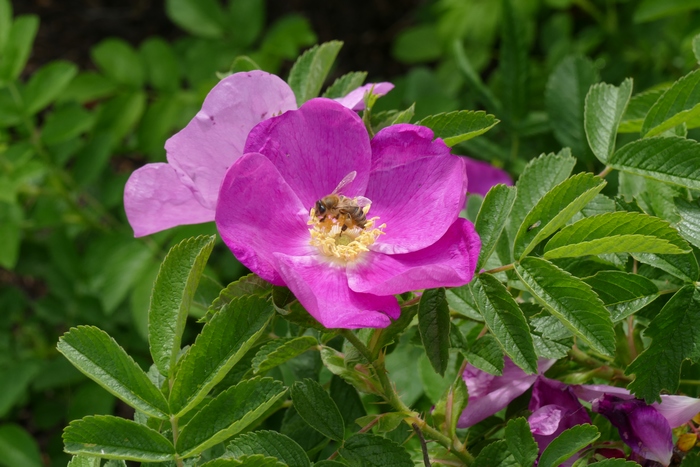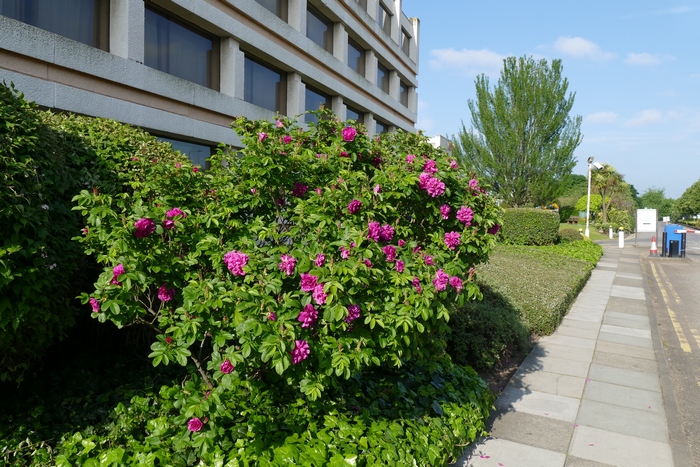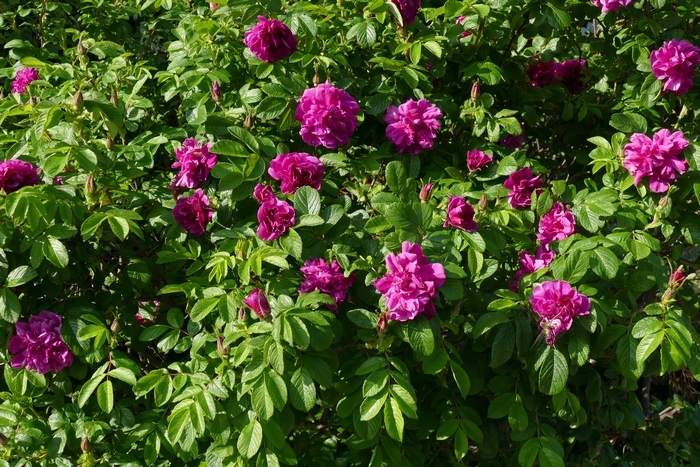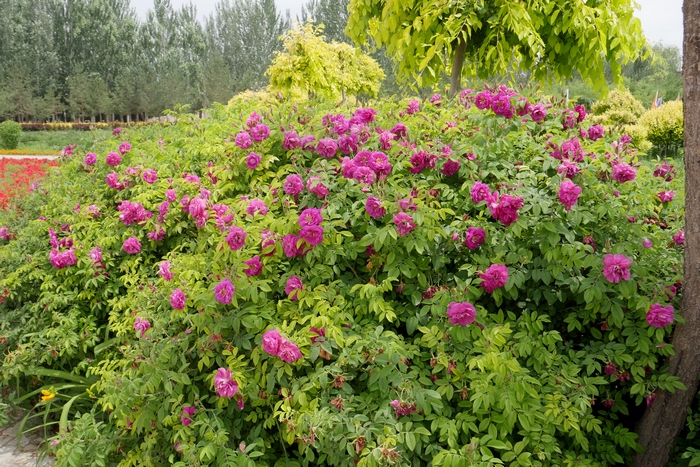玫瑰Rosa rugosa




中文
名(Chinese Name):玫瑰
学名(Scientific Name):Rosa rugosa Thunb.
英文名(English Common Name):rugosa rose
别名(Chinese Common Name):
异名(Synonym):Rosa ferox Lawrance Rosa andreae Lange Rosa coruscans Waitz ex Link Rosa rugosa var. albiflora Koidz. Rosa x regeliana Linden & Andr‚
科属(Family & Genus):蔷薇科(Rosaceae)蔷薇属
形态特征(Description):直立灌木,高可达2米;茎粗壮,丛生;小枝密被绒毛,并有针刺和腺毛,有直立或弯曲、淡黄色的皮刺,皮刺外被绒毛。小叶5-9,连叶柄长5-13厘米;小叶片椭圆形或椭圆状倒卵形,长1.5-4.5厘米,宽1-2.5厘米,先端急尖或圆钝,基部圆形或宽楔形,边缘有尖锐锯齿,上面深绿色,无毛,叶脉下陷,有褶皱,下面灰绿色,中脉突起,网脉明显,密被绒毛和腺毛,有时腺毛不明显;叶柄和叶轴密被绒毛和腺毛;托叶大部贴生于叶柄,离生部分卵形,边缘有带腺锯齿,下面被绒毛。花单生于叶腋,或数朵簇生,苞片卵形,边缘有腺毛,外被绒毛;花梗长5 -22 5毫米,密被绒毛和腺毛;花直径4-5.5厘米;萼片卵状披针形,先端尾状渐尖,常有羽状裂片而扩展成叶状,上面有稀疏柔毛,下面密被柔毛和腺毛;花瓣倒卵形,重瓣至半重瓣,芳香,紫红色至白色;花柱离生,被毛,稍伸出萼筒口外,比雄蕊短很多。果扁球形,直径2-2.5厘米,砖红色,肉质,平滑,萼片宿存。花期5-6月,果期8-9月。
分布(Distribution):原产我国华北以及日本和朝鲜。我国各地均有栽培。
用途(Use):鲜花可以蒸制芳香油,油的主要成分为左旋香芳醇,含量最高可达千分之六,供食用及化妆品用,花瓣可以制饼馅、玫瑰酒、玫瑰糖浆,干制后可以泡茶,花蕾入药治肝、胃气痛、胸腹胀满和月经不调。果实含丰富的维生素C、葡萄糖、果糖、蔗糖、枸橼酸、苹果酸及胡萝卜素等。种子含油约14%。
引自中国植物志英文版:FOC Vol. 9 Page 358
Rosa rugosa Thunberg in Murray, Syst. Veg., ed. 14. 473. 1784.
玫瑰 mei gui| Rosaceae | Rosa
Rosa ferox Lawrence; R. pubescens Baker.
Shrubs erect, to 2 m tall. Stems fasciculate, robust; branchlets tomentose; prickles dense, yellowish, terete, straight, greatly variable in size and intermixed, to 5 mm, fine, evenly tapering to base, lower parts tomentose, intermixed with glandular bristles. Leaves including petiole 5–13 cm, thick; stipules mostly adnate to petiole, free parts ovate, abaxially tomentose, margin glandular-pubescent, apex acute; rachis and petiole tomentose, sometimes with a few, short prickles; leaflets 5–7(–9), elliptic or elliptic-obovate, 1.5–4.5 × 1–2.5 cm, abaxially tomentose, reticulate, adaxially glabrous, shiny, rugose due to concave veins, base rounded or broadly cuneate, margin acutely serrate, apex acute or rounded-obtuse. Flower solitary, or several and fasciculate, axillary, 4–5.5 cm in diam.; pedicel 5–25 mm, tomentose and glandular-pubescent; bracts ovate, abaxially tomentose, margin glandular-pubescent, apex acuminate. Hypanthium subglobose, glabrous. Sepals 5, ovate-lanceolate, often leaflike, abaxially pubescent and stipitate glandular, adaxially sparsely pubescent, pinnately lobed, apex caudate-acuminate. Petals 5, double or semi-double, purple-red, dark pink, or white, obovate, base cuneate, apex emarginate. Styles free, slightly exserted, much shorter than stamens. Hip dark red, depressed-globose, 2–2.5 cm in diam., smooth, with persistent, erect sepals. Fl. May–Jun, fr. Aug–Sep. 2n = 14*.
Coastal hillsides, sandy soils on sea shores, offshore islands; below 100 m. Native in E Jilin (Hunchun Xian), Liaoning, NE Shandong (Yantai Shi); widely cultivated elsewhere in China [Japan, Korea, Russia (Far East)].
This species has many horticultural forms widely cultivated in China. According to Fu (China Plant Red Data Book 1: 558–559. 1992), it is endangered as a wild plant by picking and uprooting.
(责任编辑:徐晔春)
踩一下[6]

顶一下[5]